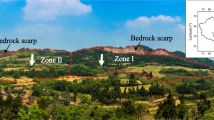Abstract
On Shikoku Island, which is one of the four main islands of Japan, a large number of large-scale crystalline schist landslides have been revealed and are being monitored by an observation system. Seasonal heavy rainfall is the most active meteorological factor that can threaten the stability of this kind of site-specific landslide. In this paper, on the basis of the study of the rainfall-related behavior of a typical crystalline schist landslide, the Zentoku landslide, by analyzing the precisely and continuously observed piezometric and movement data, a method was developed to quantitatively assess the effect of heavy rainfall on a large-scale landslide. The results indicated that heavy rainfall-induced landslide displacement shows good correlation with the variation of groundwater levels. Variations of groundwater level have been simulated with the use of a tank model. The simulation using this model permits the change in water levels for future rainfall events to be predicted. By combining the predicted results with the empirical relation between displacements and water levels, rainfall-induced landslide movement during extreme rainfall events can be estimated in advance. The effect of heavy rainfall on sliding behavior can be quantified in terms of the change in displacement. Thus warning information or advisories for the local residents can be provided.











Similar content being viewed by others
References
Furaya G, Sassa K, Hiura H, Fukuoka H (1999) Mechanism of creep movement caused by landslide activity and underground erosion in crystalline schist, Shikoku Island, southwestern Japan. Eng Geol 53:311–325
Hiura H, Sassa K, Fukuoka H (1991) On the mechanism of a crystalline schist landslide: landslide movement and the underground erosion. In: The Soviet-China-Japan Symp. and Field Workshop on Natural Disasters, Shanghai, Lanchzou, Urumgi, Alma-ata, Dushanbe and Kazsalezashchita, USSR, pp 21–30
Sassa K (1984) Monitoring of a crystalline schist landslide: compressive creep affected by “underground erosion”. In: Proceedings of 4th International Symposium on Landslide, Toronto, vol. 2, University Toronto Press, Downsview, pp 179–184
Sassa K, Takei A, Kobashi S (1980) The movement and the mechanism of a crystalline schist landslide “Zentoku” in Japan. Proc. INTERPRAEVENT 1980, Bad Ischl, vol. 1, Forschungsgesellschaft für vorbeugende Hochwasser bekämpfung, Klagenfurt, pp 85–106
Sugawara N (1972) Analysis method of valley discharge. Kyoritsu Publisher, Tokyo, Japan (in Japanese)
Watari M, Kobashi S (1987) Prediction and countermeasures of landslide and slope failure. Yamaumido publisher, Tokyo, Japan, pp 41–67 (in Japanese)
Acknowledgement
The authors wish to thank Dr. Gonghui Wang, Kyoto University and Associate Prof. Shinya Hiramatsu, Kochi University for their suggestions and discussions throughout this research. We also acknowledge the help of Dr. Furuya, Kyoto University, for his kind instruction concerning the field observations
Author information
Authors and Affiliations
Corresponding author
Rights and permissions
About this article
Cite this article
Hong, Y., Hiura, H., Shino, K. et al. Quantitative assessment on the influence of heavy rainfall on the crystalline schist landslide by monitoring system -case study on Zentoku landslide, Japan. Landslides 2, 31–41 (2005). https://doi.org/10.1007/s10346-005-0044-6
Received:
Accepted:
Published:
Issue Date:
DOI: https://doi.org/10.1007/s10346-005-0044-6




